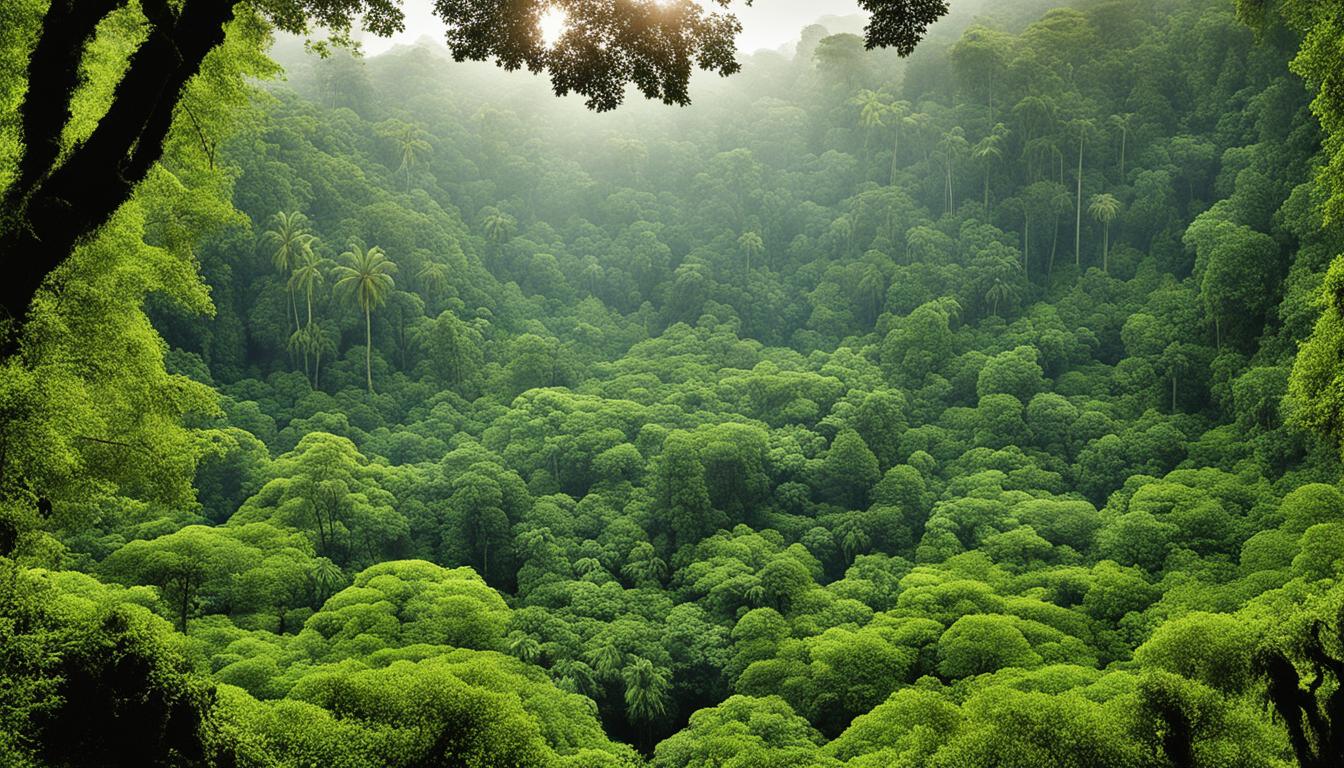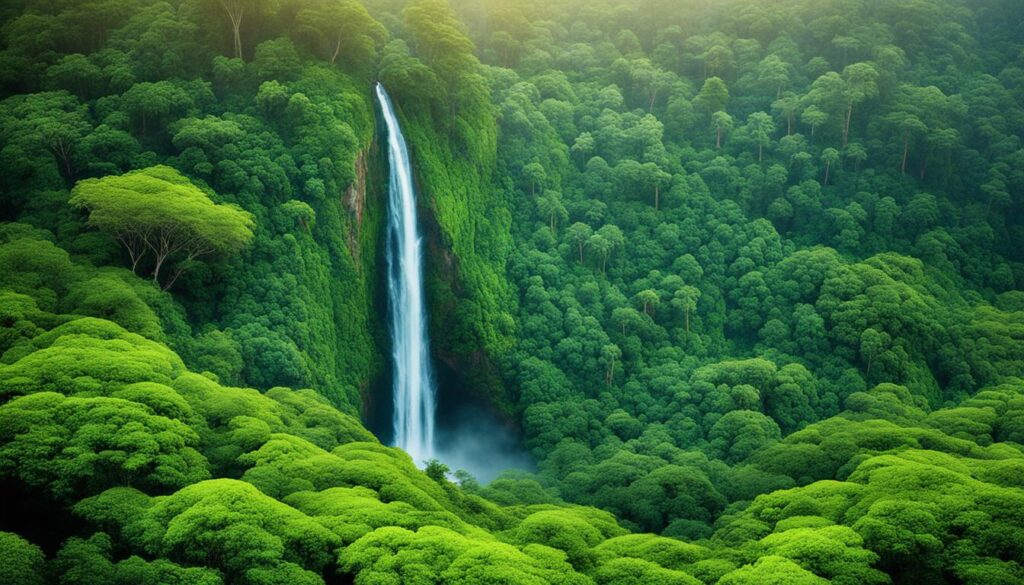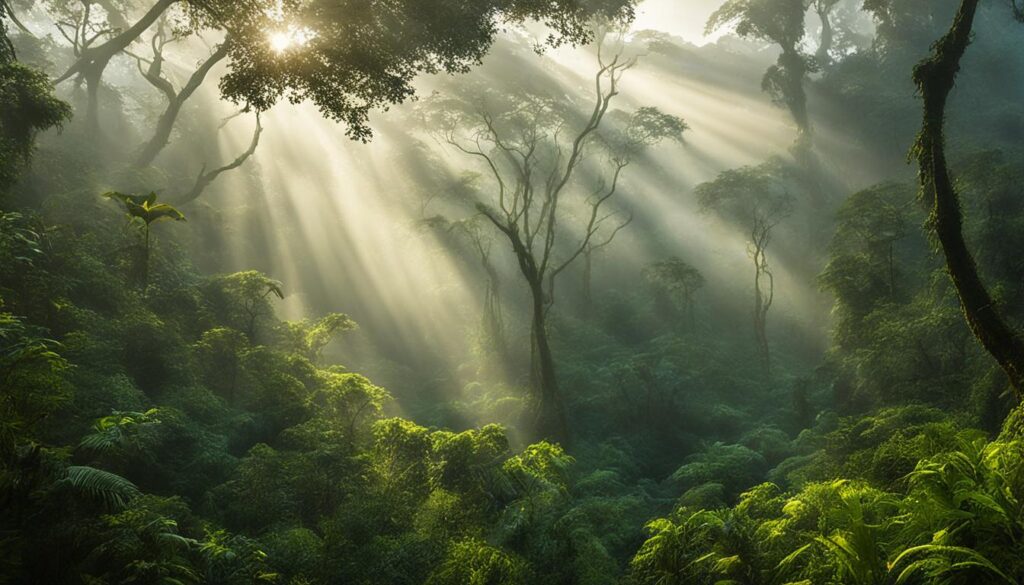
Exploring India’s Lush Rain Forests – A Guide
Did you know India has some of the world’s most amazing rain forests? With vibrant greenery and diverse wildlife, these forests are captivating. They offer a unique experience for all who love nature and adventure.
From tall trees to the sounds of exotic birds, the rain forests in India are incredible. No matter if you love wildlife, enjoy trekking, or just love nature, visiting these forests is essential. In this guide, we will show you the best rain forests in India. We will uncover their secrets and what makes them stand out.
Get ready to explore India’s magical rain forests. Each step will bring you closer to nature’s untouched beauty.
Rain Forests in India: Andaman And Nicobar Islands – Tropical Evergreen Forest
The Andaman and Nicobar Islands have a stunning tropical evergreen forest. It’s known for amazing biodiversity, with rare plants and animals from other countries. Over 2,200 plant varieties make the Andaman Islands India’s richest biosphere. This is perfect for those who love nature and wildlife.
These lush rainforests are a beautiful sight. They have tall trees and a thick canopy that keeps a vibrant ecosystem alive. The islands give a home to unique birds, reptiles, and mammals. They also protect many types of sea life, including colorful coral reefs.
Visiting from November to February is the best. The weather is cool and nice. You can explore nature and see famous spots in the Andaman Islands:
- Havelock Island: This island is known for beautiful beaches and clear waters. It’s perfect for beach fans and divers. You can see beautiful corals and sea life, or just relax on the beach.
- Diglipur: Located in North Andaman, Diglipur has calm beaches and mangrove forests. It also has Saddle Peak, the islands’ highest point. You can hike and enjoy great views.
- Baratang: Baratang is famous for its limestone caves and mud volcanoes. Visitors can explore ancient caves or see the exciting mud volcanoes.
Exploring the Andaman Islands Wildlife
The Andaman Islands have many unique land and sea animals. You might see rare Andaman wild pigs or saltwater crocodiles. Birdwatchers can spot special birds like the Andaman crake and serpent-eagle.
Enjoy the beautiful Andaman and Nicobar Islands rainforest. Whether you’re hiking, diving, or enjoying the view, it’s an unforgettable trip. Every step in these forests is a new discovery.
Rain Forests in India: Assam – Unspoiled Escapes
Assam, located in Northeast India, is perfect for nature lovers. Its isolated and unspoiled rain forests are mainly in Northern Assam. They stretch into Nagaland and Manipur. These forests are home to dense covers and wildlife like the Rhesus Macaque, Assamese Macaque, and Hoolock Gibbons. This makes Assam’s rainforests a top spot for wildlife enthusiasts.
The Assam rainforests have a wide variety of plants and animals. This makes it a place full of biodiversity. Visitors can see how different species of plants and animals live together. From tall trees to colorful flowers, nature lovers will enjoy the sights the Assam rainforest offers.
Exploring the Assam rainforest is an exciting journey. There are lots of chances for wildlife spotting, birdwatching, and walking through lush trails. The best time to visit is from October to April, thanks to the region’s nice weather.
If you want to see Assam’s wildlife up close, go to Kaziranga National Park. It’s famous for the one-horned rhinoceros, wild buffaloes, elephants, and birds. Other nice places in Assam are the North Cachar Hills and the peaceful city of Dibrugarh.
Assam’s untouched rain forests are a great place for nature lovers and adventurers. They offer a way to connect with nature and enjoy its untouched beauty.
Assam Rainforest Wildlife:
| Wildlife Species | Status |
|---|---|
| Rhesus Macaque | Least Concern |
| Assamese Macaque | Endangered |
| Hoolock Gibbons | Vulnerable |
Rain Forests in India: North Western Ghats Moist Deciduous Forests – Rich in Flora and Fauna
The northern Western Ghats, in Maharashtra and Karnataka, are known for lush moist deciduous forests. These forests spread over about 30,000 square kilometers. They are an essential part of India’s Western Ghats rainforest ecosystem.
Home to a wide variety of plants and animals, the Western Ghats rainforest is a biodiversity hotspot. Over 1,100 species of animals live here, including Asia’s biggest elephant population. The area teems with tigers, leopards, deer, and many bird species. It offers a great diversity of wildlife.
However, deforestation poses a significant threat to these forests. Two-thirds of the original forest area has been cleared. This has resulted in habitat loss for many species. Protecting what’s left of these rainforests is critical for the survival of its unique flora and fauna.
There’s much for visitors to discover in the Western Ghats rainforest. Popular spots include Bandipur Safari Lodge and Bison River Resort. Eravikulam National Park and Silent Valley National Park are also great for exploring. These places let you see the incredible biodiversity up close and experience India’s stunning rainforests.
Top Wildlife Species in the Western Ghats Rainforest:
| Animal | Status |
|---|---|
| Asian Elephant | Endangered |
| Tiger | Endangered |
| Leopard | Vulnerable |
| Lion-tailed Macaque | Endangered |
| Gaur (Indian Bison) | Vulnerable |
| Malabar Hornbill | Near Threatened |

The Western Ghats rainforests are a beautiful part of India, full of life and nature’s wonders. They provide homes for many plants and animals. Protecting these rainforests is essential for future generations and the health of our planet.
Rain Forests in India: South Western Ghats Moist Deciduous Forests – Species-rich Regions of Deccan
Kerala and Tamil Nadu boast the South Western Ghats Moist Deciduous Forests. These forests are teeming with unique species. Here, large animals like tigers, gaurs, and elephants roam free. The area is also well-known for the Neelakurinji flowers that bloom every twelve years.
This region’s rainfall ranges from 250 to 800 cm. Such conditions support a rich variety of plants including Calophyllum austroindicum, Garcinia travancorica, and Mesua ferrea. With its lush landscapes and stunning views, the South Ghats rainforest draws nature lovers and photographers worldwide.
The South Ghats rainforest is a precious gem nestled in the Deccan plateau, where nature’s wonders unfold at every step.
To truly experience these rainforests, there are many great spots to visit and stay. Kodaikanal offers beautiful hill views and Shola forest adventures. Valparai is known for its tea plantations and wildlife spotting opportunities. In Mattupetty, you can find peaceful lakes and beautiful hills, perfect for a relaxing retreat. For those who love nature, Lovedale has lush meadows and tea gardens to explore.
Explore the South Ghats Rainforest Attractions:
- Spotting tigers, gaurs, and elephants in their natural habitat
- Experiencing the breathtaking Neelakurinji flower bloom
- Trekking through the verdant rainforest trails
- Visiting tea plantations and witnessing the tea-making process
- Capturing stunning views of mist-covered valleys and cascading waterfalls
The South Ghats rainforest is a top destination for those who love nature. Dive into the wonders of Kerala and Tamil Nadu’s rainforests. Make lasting memories surrounded by the beauty of nature.

Rain Forests in India: Brahmaputra Valley Semi-Evergreen Forests – Home to the Most Alluvial Soil
The Brahmaputra Valley in Assam is filled with semi-evergreen forests. It’s known for amazing biodiversity and fertile alluvial soil. This soil helps support a highly productive ecosystem. Thanks to this, the area is a perfect living space for many wildlife species. Creatures like the Golden langur, Hoolock Gibbon, and Stump-tailed Macaque call it home.
These forests bring together elements from the Indo-Malayan region. This mix results in unique plant life that’s not found elsewhere in India. The area’s dense green cover and special plants are not just pretty. They are also crucial for the people living there. The locals use the forests for agriculture and find pastures for their animals, making a living from the land.
“The Brahmaputra Valley rainforest in Assam is a true natural treasure. Its semi-evergreen forests and alluvial soil create a thriving ecosystem. It’s vital for keeping many wildlife species safe. Exploring this area is an amazing journey through the beautiful rainforests of India.”
Wild Grass Lodge: A Gateway to Nature’s Paradise
Looking for a deep dive into the Brahmaputra Valley’s rainforests? Wild Grass Lodge is your ideal spot. It sits right in the midst of lush nature. This eco-friendly lodge has cozy rooms and leads tours into the rainforests. You can go on walks or look for birds, all to see the incredible plant and animal life up close.
| Location | Accommodation | Activities |
|---|---|---|
| Wild Grass Lodge | Risong Guest House | Mehao Wildlife Sanctuary |
Risong Guest House is another wonderful place to stay. It matches perfectly with the natural environment. Here, you can relax and soak up the rainforest’s beauty and sounds. If you’re seeking thrills, Mehao Wildlife Sanctuary has you covered. This sanctuary gives you a chance to see both rare and endangered animals in the wild.
The Brahmaputra Valley rainforest in Assam is packed with stunning views and diverse creatures. Dive into nature, learn about the alluvial soil rainforest, and make unforgettable memories. This beautiful part of India is waiting for you.
Conclusion
India’s rain forests are amazing, with lots of life and stunning natural sights. The Andaman and Nicobar Islands and the Western Ghats are just two examples. If you love nature, wildlife, or adventure, these forests will impress you.
When you visit, show respect for the ecosystems. It’s key to keep these places beautiful for the future. By being careful, following rules, and supporting eco-friendly tourism, we help preserve India’s rain forests.
Traveling through India’s rain forests means more than seeing great views and animals. It’s a deep connection with nature. Walking among the tall trees and colorful plants, you feel part of the life there.
So, get ready for an adventure in India’s rain forests. Dive into the beauty around you. Let the magic of these forests touch your heart and make memories that stay with you forever.
FAQ
What are the best times to visit the rain forests in India?
The best time to visit India’s rain forests varies by region. For the Andaman and Nicobar Islands, visit from November to February. For Assam, October to April is ideal. In the Western Ghats and Brahmaputra Valley, aim for the cooler months between November and February.
What are some popular places to explore in the rain forests of India?
In the Andaman and Nicobar Islands, must-see spots include Havelock Island, Diglipur, and Baratang. Assam offers wonders like Kaziranga National Park, North Cachar Hills, and Dibrugarh. In the Western Ghats, check out places like Bandipur Safari Lodge and Eravikulam National Park. Kerala and Tamil Nadu boast gems like Kodaikanal and Valparai.
What is the wildlife like in the rain forests of India?
The rain forests of India teem with diverse, unique wildlife. Discover rare species in the Andaman and Nicobar Islands. Assam is home to creatures such as the Rhesus Macaque and Hoolock Gibbons. The Western Ghats are famous for elephants while the South Western Ghats shelter tigers and gaurs. In the Brahmaputra Valley, look out for the Golden langur and Stump-tailed Macaque.
What is the biodiversity like in the rain forests of India?
India’s rain forests are biodiversity hotspots. The Andaman and Nicobar Islands alone host over 2,200 plant varieties. The Western Ghats have a large elephant population among their 1,100 animal species. The South Western Ghats feature unique plants and animals. The Brahmaputra Valley thrives with semi-evergreen forests and a productive ecosystem.
What are some conservation concerns for the rain forests in India?
Deforestation poses a major threat to India’s rain forests, especially in the Western Ghats. Over two-thirds of this area has been cleared. It’s vital to focus on conservation efforts. Visiting these fragile ecosystems carefully helps preserve them for future generations.
What makes exploring the rain forests in India an unforgettable experience?
Exploring India’s rain forests is unforgettable for its unique attractions. These include diverse wildlife and serene locations. Each forest offers something special, from rare species in the Andaman and Nicobar Islands to lush escapes in Assam. The Western Ghats and their vivid biodiversity are truly captivating. These rain forests are a top destination for anyone.
Source Links
- https://traveltriangle.com/blog/rain-forests-in-india/
- https://wanderon.in/blogs/silent-valley-in-kerala
- https://timesofindia.indiatimes.com/travel/travel-guide/the-top-10-rainforests-and-jungles-in-the-world/gs40613996.cms

Leave a Reply